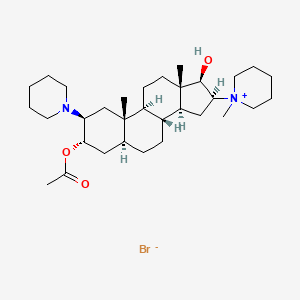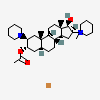17-Deacetyl vecuronium bromide
- 3-Desacetyl Vecuronium
- 50587-95-6
- 17-Deacetyl vecuronium bromide
- 8S61ZS49CN
- 17-Deacetylvecuronium
- Create:2007-02-09
- Modify:2025-01-04

- 17-deacetylvecuronium
- 17-hydroxyvecuronium
- ORG NC 58
- ORG-NC-58
- 3-Desacetyl Vecuronium
- 50587-95-6
- 17-Deacetyl vecuronium bromide
- 8S61ZS49CN
- 17-Deacetylvecuronium
- [(2S,3S,5S,8R,9S,10S,13S,14S,16S,17R)-17-hydroxy-10,13-dimethyl-16-(1-methylpiperidin-1-ium-1-yl)-2-piperidin-1-yl-2,3,4,5,6,7,8,9,11,12,14,15,16,17-tetradecahydro-1H-cyclopenta[a]phenanthren-3-yl] acetate;bromide
- 1-[(2beta,3alpha,5alpha,16beta,17beta)-3-(Acetyloxy)-17-hydroxy-2-(1-piperidinyl)androstan-16-yl]-1-methylpiperidiniu
- 1-[(2beta,3alpha,5alpha,16beta,17beta)-3-(Acetyloxy)-17-hydroxy-2-(1-piperidinyl)androstan-16-yl]-1-methylpiperidinium Bromide
- 17-hydroxyvecuronium
- Org NC 58
- UNII-8S61ZS49CN
- ORG-NC-58
- Vecuronium Bromide EP Impurity E
- 17-DEACETYLVECURONIUM BROMIDE
- AKOS030242906
- Q27270951
- 1-(3.ALPHA.-(ACETYLOXY)-17.BETA.-HYDROXY-2.BETA.-(PIPERIDIN-1-YL)-5.ALPHA.-ANDROSTAN-16.BETA.-YL)-1-METHYLPIPERIDINIUM BROMIDE
- 1-[(2beta,3alpha,5alpha,16beta,17beta)-17-(Acetyloxy)-3-hydroxy-2-(1-piperidinyl)androstan-16-yl]-1-methylpiperidinium Bromide
- 5alpha-Androstan-3alpha,17beta-diol, 16beta-pipecolinio-2beta-piperidinio-,bromide,3-acetate
- PIPERIDINIUM, 1-((2.BETA.,3.ALPHA.,5.ALPHA.,16.BETA.,17.BETA.)-3-(ACETYLOXY)-17-HYDROXY-2-(1-PIPERIDINYL)ANDROSTAN-16-YL)-1-METHYL-, BROMIDE
- Piperidinium, 1-(3-alpha-acetoxy-17-beta-hydroxy-2-beta-piperidino-5-alpha-androstan-16-beta-yl)-1-methyl-, bromide
- Piperidinium, 1-[(2ss,3a,5a,16ss,17ss)-3-(acetyloxy)-17-hydroxy-2-(1-piperidinyl)androstan-16-yl]-1-methyl-, bromide (9CI); Androstane, piperidinium deriv.; Org-NC 58; Vecuronium Bromide Imp. E (EP); Vecuronium Bromide Related Compound B (USP)

H300 (100%): Fatal if swallowed [Danger Acute toxicity, oral]
H310 (100%): Fatal in contact with skin [Danger Acute toxicity, dermal]
H330 (100%): Fatal if inhaled [Danger Acute toxicity, inhalation]
P260, P262, P264, P270, P271, P280, P284, P301+P316, P302+P352, P304+P340, P316, P320, P321, P330, P361+P364, P403+P233, P405, and P501
(The corresponding statement to each P-code can be found at the GHS Classification page.)
Acute Tox. 2 (100%)
Acute Tox. 1 (100%)
Acute Tox. 1 (100%)
- CAS Common ChemistryLICENSEThe data from CAS Common Chemistry is provided under a CC-BY-NC 4.0 license, unless otherwise stated.https://creativecommons.org/licenses/by-nc/4.0/Piperidinium, 1-[(2β,3α,5α,16β,17β)-3-(acetyloxy)-17-hydroxy-2-(1-piperidinyl)androstan-16-yl]-1-methyl-, bromidehttps://commonchemistry.cas.org/detail?cas_rn=50587-95-6
- ChemIDplus17-Deacetylvecuroniumhttps://pubchem.ncbi.nlm.nih.gov/substance/?source=chemidplus&sourceid=0050587956ChemIDplus Chemical Information Classificationhttps://pubchem.ncbi.nlm.nih.gov/source/ChemIDplus
- European Chemicals Agency (ECHA)LICENSEUse of the information, documents and data from the ECHA website is subject to the terms and conditions of this Legal Notice, and subject to other binding limitations provided for under applicable law, the information, documents and data made available on the ECHA website may be reproduced, distributed and/or used, totally or in part, for non-commercial purposes provided that ECHA is acknowledged as the source: "Source: European Chemicals Agency, http://echa.europa.eu/". Such acknowledgement must be included in each copy of the material. ECHA permits and encourages organisations and individuals to create links to the ECHA website under the following cumulative conditions: Links can only be made to webpages that provide a link to the Legal Notice page.https://echa.europa.eu/web/guest/legal-noticePiperidinium,1-[(2beta,3alpha,5alpha,16beta,17beta)-3-(acetyloxy)-17-hydroxy-2-(1-piperidinyl)androstan-16-yl]-1-methyl-, bromide (9CI)https://echa.europa.eu/substance-information/-/substanceinfo/100.233.500Piperidinium,1-[(2beta,3alpha,5alpha,16beta,17beta)-3-(acetyloxy)-17-hydroxy-2-(1-piperidinyl)androstan-16-yl]-1-methyl-, bromide (9CI) (EC: 806-453-8)https://echa.europa.eu/information-on-chemicals/cl-inventory-database/-/discli/details/241825
- FDA Global Substance Registration System (GSRS)LICENSEUnless otherwise noted, the contents of the FDA website (www.fda.gov), both text and graphics, are not copyrighted. They are in the public domain and may be republished, reprinted and otherwise used freely by anyone without the need to obtain permission from FDA. Credit to the U.S. Food and Drug Administration as the source is appreciated but not required.https://www.fda.gov/about-fda/about-website/website-policies#linking17-DEACETYL VECURONIUM BROMIDEhttps://gsrs.ncats.nih.gov/ginas/app/beta/substances/8S61ZS49CN
- Wikidata17-deacetyl vecuronium bromidehttps://www.wikidata.org/wiki/Q27270951
- PubChem
- Medical Subject Headings (MeSH)LICENSEWorks produced by the U.S. government are not subject to copyright protection in the United States. Any such works found on National Library of Medicine (NLM) Web sites may be freely used or reproduced without permission in the U.S.https://www.nlm.nih.gov/copyright.html17-deacetylvecuroniumhttps://www.ncbi.nlm.nih.gov/mesh/67047941
- GHS Classification (UNECE)GHS Classification Treehttp://www.unece.org/trans/danger/publi/ghs/ghs_welcome_e.html


 CID 14029406 (17-Deacetyl vecuronium)
CID 14029406 (17-Deacetyl vecuronium) CID 260 (Hydrobromic Acid)
CID 260 (Hydrobromic Acid)